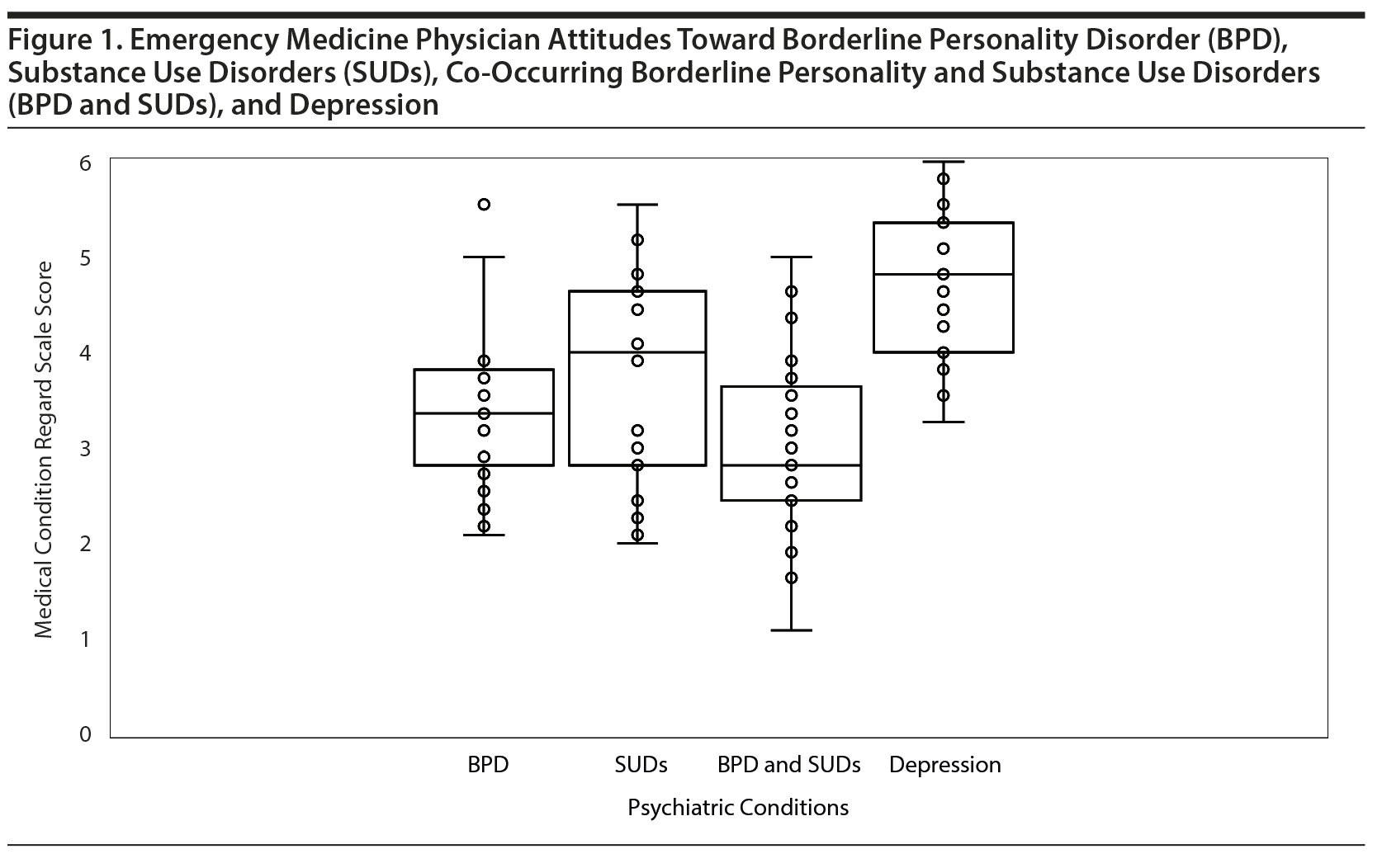Substance use disorders (SUDs) and borderline personality disorder (BPD) remain two of the most highly stigmatized disorders within medicine and society.1–5 Extensive research demonstrates that this stigma is associated with poor provider experiences in clinical interactions, including low motivation, powerlessness, decreased empathy, and wrongful bias.6–14 SUDs and BPD also frequently co-occur, with a study15 reporting co-occurrence rates as high as 53.2%. In that same study, rates of lifetime SUDs with BPD ranged from 45.5% to 86.2%.15 The overlap and exacerbation of symptoms of one disorder by the other lead to incomplete or missed diagnoses and, subsequently, improper management strategies, which further contribute to provider frustration.5,16–21 Patients with these disorders often present to the emergency department (ED) with overdose, intoxication, trauma, or self-harm, making the ED a frequent setting for affectively intense encounters with such patients.16,22–28 The goal of the current study was to evaluate emergency medicine physician attitudes toward these patients.
Methods
The study used a cross-sectional survey design and was conducted between December 2019 and March 2020. The Weill Cornell Medicine Institutional Review Board approved the study. The respondents included residents and board-certified attending physicians in emergency medicine across hospitals in New York City. The questionnaire comprised the Medical Condition Regard Scales (MCRS).29 The MCRS is a valid and reliable 11-item instrument scored on a 6-point Likert scale, designed to assess the degree to which clinicians find individuals with a given medical condition to be enjoyable, treatable, and worthy of medical resources.29 Higher scores indicate greater enjoyment, perceived treatability, and belief in the utility of dedicating medical resources for treatment. The 4 diagnoses assessed in the questionnaire included BPD, SUDs, co-occurring BPD and SUDs, and depression. A between-subjects analysis of variance multivariate test and post hoc paired t tests (95% CI) were used to compare differences between groups. SurveyMonkey and SPSS v.26 (IBM, Armonk, New York) were used for survey response collection and analysis, respectively.
Results
A total of 35 emergency medicine physicians completed the questionnaire. Results showed significant differences in attitudes across the conditions (Wilks Λ = 0.164, F3,32 = 54.35, P = .0005) (Figure 1). Multiple paired samples t tests indicated that attitudes toward depression (mean = 4.6727, SD = 0.7203) were significantly higher than attitudes toward BPD (mean = 3.3455, SD = 0.7082), SUD (mean = 3.7688, SD = 1.0667), and BPD/SUDs (mean = 2.9351, SD = 0.8760). The greatest difference was between attitudes toward depression versus co-occurring BPD/SUD (P < .001), followed by those toward BPD/SUDs versus SUD (P < .001). The difference in attitudes toward SUD and BPD was not significant (P = .09). Of respondents, 63.2% stated they did not feel adequately trained to treat patients with SUD or BPD. Lastly, respondents reported borderline or substance use disorders made up 8.75% of all patients seen within their past week.
Discussion
Our results demonstrate worse attitudes toward patients with co-occurring BPD and SUD than toward patients with just 1 of these conditions or depression. Depression was most favorably regarded, despite both its high co-occurrence with BPD/SUDs and its role in triggering ED visits (eg, relapse, interpersonal problems, diffuse sense of self) in those with BPD or SUDs.3,4,17,18,30 Most notably, roughly two-thirds of physicians stated that their training was inadequate to treat these disorders, emphasizing the need to integrate best treatment practices for SUDs and co-occurring mental illness into residency curricula.
Such results are consistent with research2,31 suggesting physicians’ perceptions of their own treatment agency might influence their overall attitude toward a medical condition. Adequate treatment might be predicated on physicians’ ability to recognize and manage their own responses to complex and affect-laden patient presentations, such as guilt, hostility, helplessness, or rescue.6,11,19,26,30 Greater training in navigating the intense affects that these patients exhibit and evoke may alleviate burnout associated with repeated negative patient encounters and improve patient outcomes.
Published online: August 13, 2020.
Potential conflicts of interest: None.
Funding/support: Dr Avery was supported by the Department of Defense through external funding by the National Defense Science & Engineering Graduate Fellowship Program.
Role of the sponsor: The sponsor was responsible for review of the manuscript.
REFERENCES
1. Gunderson J. Handbook of Good Psychiatric Management for Borderline Personality Disorder. Arlington, VA: American Psychiatric Publishing; 2015.
2. Avery JD, Avery JJ, eds. The Stigma of Addiction: An Essential Guide. Springer Nature, Switzerland: Springer; 2019.
3. Hong V. Borderline personality disorder in the emergency department: good psychiatric management. Harv Rev Psychiatry. 2016;24(5):357–366. PubMed CrossRef
4. Trull TJ, Sher KJ, Minks-Brown C, et al. Borderline personality disorder and substance use disorders: a review and integration. Clin Psychol Rev. 2000;20(2):235–253. PubMed CrossRef
5. van Boekel LC, Brouwers EP, van Weeghel J, et al. Stigma among health professionals towards patients with substance use disorders and its consequences for healthcare delivery: systematic review. Drug Alcohol Depend. 2013;131(1–2):23–35. PubMed CrossRef
6. Ballon BC, Skinner W. “Attitude is a little thing that makes a big difference”: reflection techniques for addiction psychiatry training. Acad Psychiatry. 2008;32(3):218–224. PubMed CrossRef
7. Avery J, Zerbo E. Improving psychiatry residents’ attitudes toward individuals diagnosed with substance use disorders. Harv Rev Psychiatry. 2015;23(4):296–300. PubMed CrossRef
8. Avery J, Han BH, Zerbo E, et al. Changes in psychiatry residents’ attitudes towards individuals with substance use disorders over the course of residency training. Am J Addict. 2017;26(1):75–79. PubMed CrossRef
9. Lindberg M, Vergara C, Wild-Wesley R, et al. Physicians-in-training attitudes toward caring for and working with patients with alcohol and drug abuse diagnoses. South Med J. 2006;99(1):28–35. PubMed CrossRef
10. Gilchrist G, Moskalewicz J, Slezakova S, et al. Staff regard towards working with substance users: a European multi-centre study. Addiction. 2011;106(6):1114–1125. PubMed CrossRef
11. Park DB, Berkwitt AK, Tuuri RE, et al. The hateful physician: the role of affect bias in the care of the psychiatric patient in the ED. Am J Emerg Med. 2014;32(5):483–485. PubMed CrossRef
12. Corrigan P, Markowitz FE, Watson A, et al. An attribution model of public discrimination towards persons with mental illness. J Health Soc Behav. 2003;44(2):162–179. PubMed CrossRef
13. Weiner B, Perry RP, Magnusson J. An attributional analysis of reactions to stigmas. J Pers Soc Psychol. 1988;55(5):738–748. PubMed CrossRef
14. Livingston JD, Milne T, Fang ML, et al. The effectiveness of interventions for reducing stigma related to substance use disorders: a systematic review. Addiction. 2012;107(1):39–50. PubMed CrossRef
15. Trull T, Solhan M, Brown W, et al. Substance use disorders and personality disorders. In: Sher K, ed. Oxford Handbook of Substance Use Disorders. Oxford, United Kingdom: Oxford University Press; 2016.
16. Shaikh U, Qamar I, Jafry F, et al. Patients with borderline personality disorder in emergency departments. Front Psychiatry. 2017;8:136. PubMed
17. Pennay A, Cameron J, Reichert T, et al. A systematic review of interventions for co-occurring substance use disorder and borderline personality disorder. J Subst Abuse Treat. 2011;41(4):363–373. PubMed CrossRef
18. Pettinati H. O’Brien C, Dundon W. Current status of co-occurring mood and substance use disorders: a new therapeutic target. Focus. 2015;13(3):356–362. CrossRef
19. Wolitzky-Taylor K, Operskalski JT, Ries R, et al. Understanding and treating comorbid anxiety disorders in substance users: review and future directions. J Addict Med. 2011;5(4):233–247. PubMed CrossRef
20. Tolliver BK, Anton RF. Assessment and treatment of mood disorders in the context of substance abuse. Dialogues Clin Neurosci. 2015;17(2):181–190. PubMed
21. Avery J, Barnhill J, eds. Co-Occurring Mental Illness And Substance Use Disorders: A Guide To Diagnosis And Treatment. Arlington, VA: American Psychiatric Association Publishing; 2017.
22. Chaput YJ, Lebel MJ. Demographic and clinical profiles of patients who make multiple visits to psychiatric emergency services. Psychiatr Serv. 2007;58(3):335–341. PubMed CrossRef
23. Pasic J, Russo J, Roy-Byrne P. High utilizers of psychiatric emergency services. Psychiatr Serv. 2005;56(6):678–684. PubMed CrossRef
24. Scalzo F, Hulbert CA, Betts JK, et al. Substance use in youth with borderline personality disorder. J Pers Disord. 2018;32(5):603–617. PubMed CrossRef
25. Sullivan PF, Bulik CM, Forman SD, et al. Characteristics of repeat users of a psychiatric emergency service. Hosp Community Psychiatry. 1993;44(4):376–380. PubMed CrossRef
26. Beresin E, Gordon C. Emergency ward management of the borderline patient. Gen Hosp Psychiatry. 1981;3(3):237–244. PubMed CrossRef
27. Perlmutter RA. The borderline patient in the emergency department: an approach to evaluation and management. Psychiatr Q. 1982;54(3):190–197. PubMed CrossRef
28. Gunderson JG. Reducing suicide risk in borderline personality disorder. JAMA. 2015;314(2):181–182. PubMed CrossRef
29. Christison GW, Haviland MG, Riggs ML. The Medical Condition Regard Scale: measuring reactions to diagnoses. Acad Med. 2002;77(3):257–262. PubMed CrossRef
30. Moukaddam N, AufderHeide E, Flores A, et al. Shift, interrupted: strategies for managing difficult patients including those with personality disorders and somatic symptoms in the emergency department. Emerg Med Clin North Am. 2015;33(4):797–810. PubMed CrossRef
31. Blumner KH, Marcus SC. Changing perceptions of depression: ten-year trends from the general social survey. Psychiatr Serv. 2009;60(3):306–312. PubMed CrossRef
aDepartment of Psychiatry, Weill Cornell Medical College, NewYork-Presbyterian Hospital, New York, New York
bDepartment of Emergency Medicine, Weill Cornell Medical College, NewYork-Presbyterian Hospital, New York, New York
cDepartment of Psychiatry, NYU School of Medicine, Bellevue Hospital, New York, New York
dDepartment of Psychology, Princeton University, Princeton, New Jersey
*Corresponding author: Giselle Appel, MS, Department of Psychiatry
Weill Cornell Medical College, NewYork-Presbyterian Hospital, 525 East 68th Street, Box 140, New York, New York 10065 ([email protected]).
Prim Care Companion CNS Disord 2020;22(4):20br02674
To cite: Appel G, Zaidi SR, Han BH, et al. A call for increased psychiatric training in emergency medicine: physician attitudes toward substance use disorders and co-occurring borderline personality disorder. Prim Care Companion CNS Disord. 2020;22(4):20br02674.
To share: https://doi.org/10.4088/PCC.20br02674
© Copyright 2020 Physicians Postgraduate Press, Inc.
Please sign in or purchase this PDF for $40.00.




